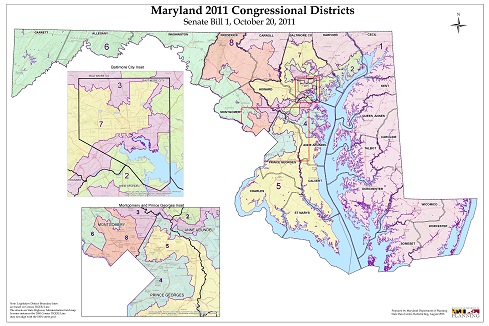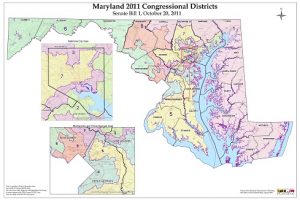Argument preview: For the second time this term, justices to take up partisan gerrymandering

on Mar 23, 2018 at 10:53 am

In October, the Supreme Court heard oral argument in a case alleging that Wisconsin’s Republican-controlled legislature had drawn the state’s redistricting plan to put Democrats at a disadvantage – a claim known as “partisan gerrymandering.” The plaintiffs challenging that plan argued that it violated their constitutional right to be treated equally under the law, but Justice Anthony Kennedy suggested that the issue might be better framed as a violation of the freedom of speech and association guaranteed by the First Amendment. Next week, the justices will hear oral argument in another redistricting case – this time, a challenge by Republican voters to a single federal congressional district drawn by Democratic officials in Maryland – presenting precisely that question. The Supreme Court’s rulings in the Wisconsin and Maryland cases will almost certainly shape the face of redistricting for years, if not decades, to come.

The justices have long struggled with the question of what, if anything, courts should do about partisan gerrymandering. In 2004, a deeply divided Supreme Court declined to step into a dispute over Pennsylvania’s redistricting plan. Four of the justices – Justice Antonin Scalia, joined by then-Chief Justice William Rehnquist and Justices Sandra Day O’Connor and Clarence Thomas – agreed that courts should never review partisan-gerrymandering claims, because it is too difficult to determine when politics plays too influential a role in redistricting. Four different justices – Justices John Paul Stevens, David Souter, Ruth Bader Ginsburg and Stephen Breyer – would have ruled that courts can review partisan-gerrymandering claims. That left Justice Anthony Kennedy, who agreed that the Supreme Court should not get involved in the Pennsylvania case but left the door open for courts to review future partisan-gerrymandering cases if a workable standard could be found.
At October’s oral argument in the Wisconsin case, there seemed to be a fairly broad consensus that partisan gerrymandering is, as Justice Samuel Alito indicated, “distasteful.” But there was no apparent agreement on whether courts should review partisan-gerrymandering claims or, if so, what standard they should use to do so. In particular, some of the court’s more conservative justices worried aloud that the statistics-based standards proposed by the Wisconsin challengers were, as Chief Justice John Roberts put it, “sociological gobbledygook” that the general public wouldn’t be able to understand. That, Roberts believed, would lead to a perception that the court favored the winning side, which would in turn “cause very serious harm to the status and integrity of the decisions of this Court in the eyes of the country.”
Two months after the oral argument in the Wisconsin case, the justices announced that they would also review the Maryland case, known in the Supreme Court as Benisek v. Lamone. The plaintiffs in the case contend that Democratic election officials in Maryland gerrymandered the state’s 6th congressional district in 2011 in retaliation for the plaintiffs’ support for Republican candidates – specifically, Roscoe Bartlett, who represented them in Congress for two decades. Although election officials only had to adjust the district by approximately 11,000 votes to account for the most recent census results, the plaintiffs argue, they instead moved out roughly half of the existing district’s residents, creating “more than a 90,000-voter swing in favor of registered Democrats—a complete upheaval for a district in which typically 230,000 voters cast ballots in midterm elections.” As a result, although Bartlett had won re-election in 2010 by a margin of 28%, in 2012 he lost by a margin of 21% to John Delaney, who announced last year that he would seek the Democratic nomination for president in 2020 rather than running for re-election. More broadly, the plaintiffs allege, the partisan gerrymander also violated the First Amendment because it “disrupted and depressed Republican political engagement in the area, and manifestly diminished their opportunity for political success.”
The dispute now before the Supreme Court centers on what the plaintiffs must show for their First Amendment retaliation challenge to partisan gerrymandering to go forward. Federal law requires that the initial review of redistricting challenges be conducted by a three-judge panel. The plaintiffs in this case argue that the three-judge district court required them to show that the gerrymander had changed the outcome of the election and would change the outcomes of future elections as well. But all they should have to show, the plaintiffs maintain, is that they have suffered some injury.
More generally, however, the plaintiffs try to assuage the concerns voiced at October’s oral argument in the Wisconsin gerrymandering case, and to convince the justices that the First Amendment retaliation doctrine provides a “ready-made” and manageable standard with which to review partisan-gerrymandering claims. In particular, and unlike partisan-gerrymandering claims alleging violations of the right to equal protection under the law, First Amendment retaliation claims don’t require courts to determine when political considerations become too influential. Instead, the plaintiffs contend, courts simply have to determine whether a redistricting plan imposes “a real and practical burden” on the plaintiffs “in retaliation for past political support for the opposition party.” Those burdens can range from the obvious, such as drawing the map in a way that would “make it effectively impossible for opposition candidates to win,” to the less tangible – for example, stifling voter engagement and support. But the important thing, the plaintiffs emphasize, is that such burdens can be evaluated with “traditional evidence” under “familiar legal standards.”
Evaluating partisan-gerrymandering claims as First Amendment retaliation claims would have other advantages, the plaintiffs continue. Because First Amendment retaliation claims are personal to each plaintiff, they note, the claims are litigated district by district, rather than statewide – just like race-based redistricting claims. Given the frequent correlation between race and party identification, the plaintiffs suggest, recognizing such retaliation claims “would eliminate the need for courts to disentangle race and politics in redistricting cases and better ensure that the right to vote is protected regardless of political persuasion or race.”
A ruling for the plaintiffs would not mean that mapmakers can never consider politics when drawing new districts, they stress. Mapmakers can certainly take politics into account, and they can even use data containing information about when residents voted and their party affiliation. But what mapmakers can’t do, they conclude, is use that data to make “it harder for a particular group of voters to achieve electoral success because of the views they had previously expressed.”
State officials push back against the idea that the 2011 map of the 6th district was drawn to retaliate against the plaintiffs for their support of Republican candidates. Instead, they tell the justices, the 2011 plan simply restored the 6th district to something along the lines of what it had been for most of the 20th century, when it contained more Democrats than Republicans. This confirms, they contend, that courts shouldn’t simply look at how the latest plan compares with its predecessor. Doing so, they caution, could have the unintended effect of thwarting efforts to correct existing partisan gerrymanders. And the 6th district is still a competitive one, they observe, as evidenced by the fact that Republican governor Larry Hogan carried the district by 14 percentage points in 2014.
The state officials also maintain that First Amendment retaliation claims pose the same problem as partisan-gerrymandering claims based on a right to equal protection of the laws: There is no manageable standard by which to evaluate them. The plaintiffs’ standard for First Amendment claims gives too much discretion to the reviewing courts, the officials contend, creating the prospect that redistricting plans will be invalidated whenever there were any partisan motives at all. Courts will also have to speculate about whether the mapmakers intended to retaliate against the challengers, which is a particularly difficult task because redistricting takes into account many different views and motivations.
Nor does the fact that First Amendment retaliation claims involve only a single district, rather than a challenge to a statewide map, somehow make them preferable to equal protection claims as a cause of action to address partisan gerrymandering, the officials argue. Focusing on only one district in isolation is unrealistic, they contend, because decisions made about other districts will necessarily affect the neighboring districts. Here, for example, African-American lawmakers had asked the mapmakers to tinker with the districts in nearby Prince George’s County so that the county – whose population is 65% African American – was divided up among only two congressional districts, rather than three. The mapmakers also wanted to keep communities along the I-270 corridor, which officials describe as home “to a thriving technology sector,” all within one district.
At the oral argument in the Wisconsin redistricting case last fall, lawyer Paul Smith – who argued on behalf of the challengers – warned ominously that, because the electorate is so polarized and it has become so easy for experts to predict how people will vote, the court will be confronted with a “festival of copycat gerrymandering” if the Wisconsin map is upheld. At the same time, the justices are no doubt aware of recent political developments, including the special-election victory by Democrat Conor Lamb in a Pennsylvania district that had previously been regarded as so solidly Republican that Democrats often didn’t even put up a candidate. Will these developments give some justices comfort that, even if courts don’t step in to check partisan gerrymandering, the political process will take care of it? Or will Kennedy conclude that courts have a role to play in curbing partisan gerrymandering, and that the First Amendment retaliation doctrine provides the best framework for them to do so? We’ll know more after Wednesday’s argument. Stay tuned.
This post was originally published at Howe on the Court.


